Kategorie: ‘Biology’
My Internship at the EHU Bilbao
- Biology M. Sc.
- Spain, Bilbao
- Universidad del País Vasco (UPV)/ Euskal Herriko Unibertsitatea (EHU)
- 07/2024 – 09/2024
When I reached out to the Cell Communication and Transcription Lab at EHU Bilbao for a placement, I was quickly connected with my future supervisor. We arranged an online Zoom meeting, and from the start, I felt genuinely welcomed. She was incredibly helpful in organizing my stay, handling all the necessary university paperwork, and went out of her way to ensure everything was in place. It was at that moment I knew I would be well-supervised, and that this internship would be a great success.

© Jule Wahl
Although the university is located far outside the city, I was advised to find accommodation in the city center for better social connections and public transportation. I found my room on Idealista, a popular platform for finding apartments in Spain. For me, finding a reasonably priced room in a shared apartment near the river was relatively easy, but knowing at least some Spanish greatly helps in communicating with landlords, who often speak only Spanish. I ended up living with a girl from Catalunya, a girl from Peru, and one from France. Two of them were students, and the other was working. We got along really well, and they made every effort to make me feel welcome and comfortable in the flat. While we didn’t spend much time together in the end, it was still nice getting to know them!
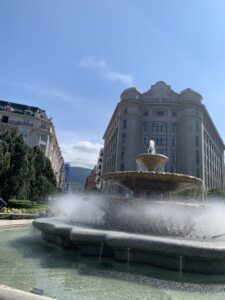
© Jule Wahl
My first impression of the city was different from what I expected of a typical Spanish city. This is because Bilbao is not quite Spain—it’s the Basque Country, something I later learned is very important to acknowledge. The architecture reminded me more of Central Europe, with modern and stylish buildings. The Nervión River flowing through the city provides a contrast to the otherwise dense urban landscape, creating a special atmosphere, especially at night when the lanterns reflect off the water. I really enjoyed taking walks by the river towards the old town, chatting with friends or responding to voice messages, as there are parks and green spaces along the way. The old town (Casco Viejo) is beautiful to explore and becomes even more vibrant at night. Every day of the week, you can find people enjoying drinks and Pintxos, the Basque version of tapas. My favorite Pintxos were the mini burgers and slices of baguette topped with various salads.
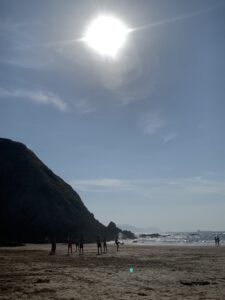
© Jule Wahl
Nature in Bilbao is lush and green, thanks to the high humidity and frequent rain. The surrounding hills and mountains offer excellent hiking routes with stunning scenery, such as the trails around Trapagaran. About 40 minutes from the city center by public transport, you’ll find large, beautiful beaches with breathtaking cliffs and sunsets. My favorite was Sopelana Beach, which I highly recommend for a spectacular sunset.
Because my stay coincided with exam season and the university’s semester break, there weren’t many students on campus, and the Erasmus students left a week after I arrived. However, I was part of the Happy Erasmus WhatsApp group for Bilbao, which allowed me to join their last gathering. Not knowing anyone in the city, I simply asked in the group chat if anyone was going out that night and if I could join them. A really nice Czech girl replied, and we met up with her group for a pre-party. We clicked instantly and had a fantastic night, which ended with a spontaneous swim in the sea. We went to a techno club called Sonora, which was a nice change from the usual bachata and salsa music. In general, Bilbao doesn’t have many clubs; it’s more common to go to small bars, particularly in Casco Viejo, where you can dance to loud music. If you’re looking for an experience full of partying and socializing with Erasmus students, I recommend coming during the semester when there are more activities and it’s easier to meet people. I also attended some language exchange meetings that I found on the Meetup app (which I highly recommend for meeting new people in a new city!) and created a Bumble BFF account specifically to find friends.
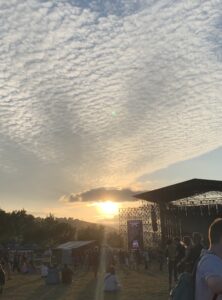
© Jule Wahl
During my stay in Bilbao, I was eager to follow the Euro 2024 football tournament in Germany, especially in the company of others. I heard about a German bar that always showed football matches, so I went there for the Germany games. I struck up a conversation with a group of young Germans, and we immediately hit it off. They were taking a language course in Bilbao, and from then on, we watched all the games together. The bar is also worth visiting—the owner is very friendly, and you can speak German with him! While I didn’t try the food, I heard great things about it. We watched the final at a public viewing event in Parque de Doña Casilda, which culminated in Spain’s victory. I also attended the popular BBK Bilbao festival, held on a hill just outside the city. It was easy to get there by bus, and we walked back afterward. I asked in the Erasmus WhatsApp chat who was going and if I could join, as I didn’t want to go alone. Fortunately, a German guy replied, inviting me to join him and his friends. We had an amazing evening, with the highlight being dancing to Jungle’s live performance. Bilbao and the surrounding towns have a lot to offer young music lovers, with numerous street fiestas and concerts during this time of year.
I highly recommend exploring the various towns around Bilbao, such as Portugalete, Santurtzi, Getxo, and Muskiz, which offer beautiful nature and charming towns. A day trip to the stunning city of San Sebastián is also well worth it, and the bus tickets are quite affordable! You can also easily travel to Madrid, Santander, Zaragoza, Vitoria-Gasteiz, Burgos, and other cities by bus or train, and if you prefer to fly, there are plenty of low-cost options to explore all of Spain.
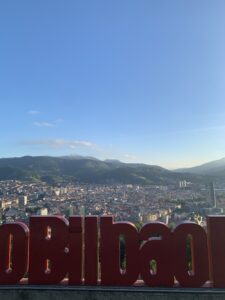
© Jule Wahl
My academic experience was also incredibly valuable. I learned a lot of methods and concepts related to working with mammalian cells and maintaining them in culture. The atmosphere in the lab was everything I could have hoped for, helping me realize what aspects are important to me in a working environment. I made many friends and colleagues who enriched my network, and I plan to stay in touch with them. This experience made me more open to meeting new people, finding ways to connect, and getting along with them right away. I’m certain it shaped my character in ways that only an experience abroad can.
Internship in Trondheim
- Biology M.Sc.
- Norway, Trondheim
- St. Olavs Hospital, Trondhiem
- 06/2023 – 11/2023
Before the stay (planning, visa, vaccinations, travel, …):
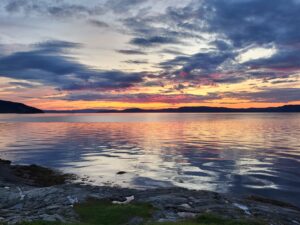
© Leona Grundel
I started an internship at St. Olavs hospital in Trondheim, which is the university hospital of NTNU,
after already spending the summer semester at NTNU. I therefore had arrived in January already
and had therefore already spend a long winter and beautiful spring their.
Regarding finding accommodation in Trondheim, the student welfare organization SIT organizes
student housing for incoming Erasmus people. Those accommodations are generally cheaper
(while I was there around 4500 NOK) than rooms on the private market (generally between 5500-
7500 NOK).
If you plan on spending the spring semester in Trondheim, your chances are good to get a place
with SIT. If you are not a student, you would have to find something on the private market, which
unfortunately usually just offers 12-months leases (July to July), few 6-months leases (July to
January; January-June) and almost never shorter leases.
Arriving in the fall semester is more difficult. Spots are very limited, and you may want to check
out the private marked. But if you like the adrenaline rush and the suspense, you can also wait
until just two weeks before you are supposed to arrive in Trondheim. I know of some people that
still got a spot with SIT this close to their departure date. NTNU and SIT are a bit last minute that
way. But speaking from experience, not everyone gets a place with SIT in fall semester.
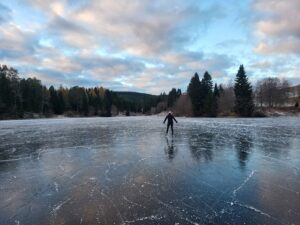
© Leona Grundel
Unfortunately, the private market housing situation in fall is not ideal either as explained above.
Also, if you extent after having started your semester abroad, be ware that, at least for an
extension into the fall semester, SIT is not guaranteeing you a place to stay. There priority is to
make space for the newly arriving exchange students which do not have the chance to go room
hunting on site.
With all the hustling around finding housing and doing all the Erasmus paperwork, the departure
time arrives quickly. Especially when arriving in summer I recommend planning a longer trip on
your way up north and visit Norway west coast or checking out Denmark and Sweden. You could
do the same if you arrive in winter but its much less fun. It’s going to be dark 80 % of the time
anyways, although I have to admit, that snowy Norway looks breathtaking.
I decided to drive up the 21 h to Trondheim with my car because I wanted to have the opportunity
to spontaneously go on road trips and other places. Although Norway in the middle of winter is
icy and snowy, the ‘’highway’’ E6 is usually ok to be driven. But it is a one lane street leading over,
around and through mountains, so in case of fresh snow you might have to wait a bit until the
streets are cleared. However, it was still cold and sometimes we drove for hours without seeing
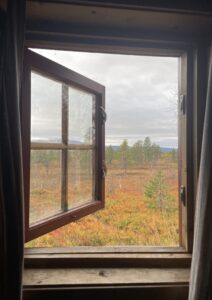
© Leona Grundel
car, while it was down to -18°C outside.
Having a car in Trondheim was especially useful since I did not have to rely on others or the public
transport to go on road trips or cabins that were further away, but you can do a lot of stuff without
one as well. Public transport in the city area is really good, and if you plan ahead you can also
reach places in the periphery a couple hour away (Just make sure to check the time table
beforehand, some bus lines drive sparsely on Sundays). And even if you want to go somewhere
where there is no good public transport connection, there are tones of Facebook groups in which
you will find yourself new friends that have cars:D Speaking of Facebook: You’ll need it.
Everything relies on Facebook: Every restaurant or club as a Facebook page (or Instagram
account) and NTNUI groups (NTNUs sports group, of which there is every sport you can imagine)
communicate and inform through it. Also, you’ll need an empty phones storage when coming
here. There are apps required for everything – laundry, NTNUI sports groups, for identification,
public transport, your student ID, renting cars…
Experience in the host country (accommodation, daily life, free time, …):
Trondheim is a bit like Aachen – a moderately sized student city with great surrounding nature.
Living in Moholt, one of the main student villages (‘’studentby’’), was awesome. This is where the
biggest chunk of Erasmus people lives. It is therefore the center of the Erasmus life. You can
spontaneously meet up in someone’s apartment (if the roomies are ok with it of course) and spend
a fun night hanging out, cooking together or drinking. But be ware, stores don’t sell alcohol after
8 pm on weekdays and 6 pm on weekends.
Next to a washing room, there are also a grocery store, a library, a café/restaurant, a gym and
even a hairdresser on the premises. Without leaving the student city you can do a BBQ, play
beach volleyball, or hang out at ‘’Lofted’’ (the common room) to play table tennis, play board
games or study (they have free coffee!).
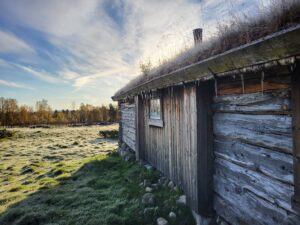
© Leona Grundel
On more thing that I really appreciate are the student run rental organizations. Check out what
the university offers, since some of these can also be used/accessed by non-students. ‘’Restore’’,
for example, is located in Moholt studentby. They collect and hand out donated furniture and
equipment to students for free. If you get one of the limited spots on their opening days you can
get everything from stools and desks to bed covers to plates and cutlery to bikes and what not.
At the end of your stay, you can easily bring that stuff back so that future exchange student benefit
from them.
Furthermore, “Bumerang” is located in Moholt studentby. They rent out everything you may need
for the outdoors for free, from tents to skies & snowboards to ice skates to fishing rods. The same
goes for the non-profit organization ‘’BUA’’. In winter, lakes are usually frozen so you can
spontaneously go ice skating there and the fjord is perfect to try out fishing or just spend the long
midsummer nights there with good food and some friends.
Continuing with the student run organizations, the “Koiene” group allows NTNUI members to rent
out their cabins in Trøndelag. Their cabins are super basic, no electricity or running water, but it
is a great way to spend a weekend away and out in nature with your friends. Here are some
pictures so you can see how beautiful it is out there. Also in fall and winter, some cabins are
perfectly located far away from any light pollution to stay up late and, with a bit of luck, see
northern lights.
Experience at the host institution (professional, cultural, …):
The internship that I did was actually my Master’s Thesis. I therefore spend most of my time at
Campus Øya in the laboratory of St. Olavs hospital. I really recommend working in their
laboratories if possible since their laboratory equipment is modern. I learned a lot, not just
academically but also about differences in how institutions are run. Be aware that there are
differences in formalities and expectations. For me it was difficult in the beginning to figure out
what requirements needed to be met. Although I tried to communicate a lot, there were still some

© Leona Grundel
misguided expectations on both sides that needed to be overcome on the way.
Furthermore, it was very interesting to talk to my colleagues with different backgrounds and to
find out about the academic structures in Norwegian research institutions, as well as the working
mentality. They really leave the office at 4 pm on the dot!
I also took a Norwegian language course. Even though you might not need the language
afterwards, it was nice to get a short introduction into the language. Especially for German
speakers it is not that hard. As a plus, you’ll also be able to understand a bit of Swedish or Danish
since their languages are closely related.
Tips for interested students:
I don’t have many more tips other than the ones I have already mentioned: Be aware of the
housing situation for the winter semester; be conscious about what it means to move somewhere
that is dark and cold most of the year; and just try to experience as much as possible. Also, for
when you arrive at NTNU, I can only encourage you to join different groups at NTNUI and maybe
try out something new. As mentioned, they have virtually everything. Normal stuff like, handball,
Taekwondo and rugby, but also fencing, diving, disc golf, dog training, horseback riding and
climbing. I for example picked up sailing and kayaking which was awesome. After the (kinda
costly) 3-days beginners course you are allowed to go to their weekly trainings for free. All of
these activities, as well as many cabin trips and meeting friends help you a lot with making it
through the dark winter hours.
My experiences in the Netherlands
- Biomedical Engineering M.Sc.
- Netherlands, Utrecht
- UMC Utrecht
- 01.06.2022 – 16.11.2022
Preparation:
To give myself some headroom to deal with the difficult housing market, I started looking for positions about nine months before the planned starting date. By the time I had found a position it was just four months to the starting date so that also had some implications on the available options in the housing market. A lot of general information pages about going abroad in the Netherlands recommend housing agencies like SSH to find student or some form of affordable housing. However, some of these agencies rely on a long waiting list, where it is more likely to get a housing offer the longer you are on the list. So, if you are running low on time, you can probably skip these options and look for alternatives, which saves you money in the process. This is another peculiarity of the Dutch housing market. While the German housing market is fairly accessible through online portals where you can see most of the available housing for free, the Dutch housing market is essentially locked behind a paywall, where most services require a subscription to contact any of the landlords. I found housing through the university hospital, which was by far the cheapest option compared to the private market. I was also required to make an appointment with the municipality for the registration purpose well in advance. I was able to get an appointment about four weeks away from the date I was looking on.
Commuting:
The Dutch system called OV-chipkaart makes commuting easy. It is essentially a prepaid (or bank account linked) public transport ticket which allows you to take every bus or train by simply checking in at the station or in the bus when you get on and checking out when you leave. It may be a little intimidating at first because you are always second guessing yourself if you have checked out correctly, but you can also register your chipkaart in the NS (Nederlandse Spoorwegen) App where you can check your latest chipcard activities. You can either order a personalized (bank account linked) card online, which takes about two weeks, or get a prepaid one at your local supermarket like Albert Heijn or Jumbo. I took the prepaid option which was still very comfortable because recharging stations are readily available at all train or bus stations and even some other locations like supermarkets. However, commuting by bus may become a noticeable financial burden because every trip you take has a flat base fee plus a per kilometre fee. Especially the base fee becomes very noticeable on short distances common inside the city.
With all of that said though, the obvious choice for commuting in the Netherlands is naturally the bike. Especially in Utrecht the bike infrastructure is exceptional. There are well maintained bike paths and bike storage everywhere which makes commuting by bike a treat. I took my bike from Aachen to Utrecht by train which is easy via the NS intercities.
Every-day life/internship:
Life in the Netherlands isn’t really all that different from life in Germany. Supermarket prices are a bit more expensive in some categories but are generally comparable to the ones you would fine here. This also applies to your average take out service, where a decent portion of fries will set you back about 3 € and a high-quality pizza is about 10 €. Payment services are also a non-issue in the Netherlands if you have a German debit card. There are very few places, if any, where you will encounter the need for cash because everything is paid by card, and I haven’t had any issues with my debit card (no extra fees or anything).
The Dutch working culture is also kind of similar but one thing I have encountered during my stay is that they put less emphasize on the lunch break. The lunch breaks were generally quite short (often just shy of 30 minutes) and primarily focused on food consumption. However, this may be attributed to the group I was working in. My internship was in the neuro engineering department of the Medical Centre Utrecht, which was a very international and highly goal oriented, so I spent a lot of time working.
Utrecht as a city also offers great recreational opportunities in forms of parks and proximity to farms around the campus. I regularly took strolls along the fields after work. If you take a bike, there are also a lot of historical landmarks within reach, including a lot of different forts and castles.
Conclusion:
While the housing situation and cost of living may be a little overwhelming in the beginning, the Dutch culture is very approachable and welcoming. The country offers a great experience in terms of travel, be it by bike or by public transport, which was a welcome change from the car centrist life in Germany. The university hospital in Utrecht is very well equipped and offers knowledge in a wide range of topics.
Toledo- an old city with a lot of Spanish flair
- Biology M.Sc.
- Spain, Toledo
- Hospital Nacional de Paraplejicos
- 04.05.2022-30.09.2022
My name is Anna, and I have been studying at the “Hospital Nacional de Paraplejicos” in Toledo from May to October 2022. I study Biology in my Masters. In the following, I will try to share knowledge with you that will help you to make the best out of your stay.
The preparation for my internship focused on transport, insurance, and housing. For my research internship abroad, I travelled to Toledo by plane. I arrived at the airport in Madrid and travelled from there to Toledo by train. If you do not want to go by plane, you can also go by railway. This takes a little bit longer, but you can combine your travel with some stopovers in other beautiful cities. Further you save some CO2 and secure the additional Erasmus funding for a green travel back home.
The health insurance is very simple. If you didn’t already have one included, you can ask your insurance to provide you with a European health insurance card. Keep in mind that most insurances do not cover rescue or repatriation in case something goes wrong on a hiking trip for example. You should ask your insurance about that.
I started to look for a flat or a room in Toledo approx. one month in advance. I made some visiting appointments for the first few days. During this time, I was living in a guest room in the professor’s house. The apartment search turned out to be very difficult. I tried to find a flat with the website “Idealista”. Many accounts didn’t even answer or other flats where small or dubious. Also, the language barrier was a big problem, due to the reason that the most landlords did not speak English. I would recommend all students doing an internship in Spain, to practice some Spanish before your internship abroad. Without the help of my work mates most of the viewing appointments were not able. Further I would recommend structuring your profile on those websites so personal as possible. If you apply for an apartment, you should always bring some personal stuff inside the texts and maybe take up some points of their advertisement.
After visiting some flats without any success, one of my workmates had the idea to look for a room in a student’s residence. I found a place in the “Residence María Immaculada Toledo”. Here I lived in a single room in the casco of Toledo. The rent for one month was 520 euros including breakfast, lunch, and dinner. This room was only available for 1 month, so I had to look for another flat in the meantime. Happily, I found my perfect flat quickly. It was a shared flat with three other Spanish girls in the age between 25-30. All three of them were as well working in the hospital. The flat was just perfect, with a large living room, a large kitchen, and a swimming pool. It was also near to the hospital, so I could walk every day by foot to the work. The rent here was 250 euros excluding extra costs like water and light.
My first impression of Toledo was impressive. It is an old city with a lot of Spanish flair. Exactly what I had expected from Spain. I applied for a position in the “Hospital nacional de paraplejicos”, to do my practical course of my master thesis there. The hospital and the investigation have their focus on spinal cord injuries. The hospital is very new and modern, and my work collogues were helpful and nice from the first moment on. I really enjoyed the work in the hospital. The willing to help was so large from all my work mates, and they integrated me into their team very quickly. I learned a lot of new techniques important for my further working live. I was working on my own project. Although the working language in the laboratory was English, it turned out to be a little bit tricky to communicate. The English knowledge of most of my collogues was rather bad. On the other hand, my Spanish knowledge was not the best. So I decided to learn a lot of Spanish int the next few weeks. The understanding was getting better from day to day. As well in English, but also in Spanish. Quickly I was able to follow conversations in Spanish and to talk some basic sentences.
With the girls of my flat I made friends quickly. They took me on hiking tours, we all signed in for the gym and they told me how to play padel tennis, a very popular sport in Spain. On the weekends we normally went out together and they introduced me to their friends. They took me to cultural events in Toledo and told me which places are worth to visit. Another positive point is the close distance to Madrid. It is only 30 minutes by train, so you can also explore the capital of Spain on the weekends.
Going to Toledo was one of the best decisions of my life. The “Hospital nacional de paraplejicos” is a great hospital with nice work mates and a great investigation department. On top, Toledo is a nice, typical Spanish city with endless opportunities and a close distance to Madrid. I hope that my short report gave you some insights into these opportunities.
Praktikum direkt am Meer: Einblicke in die marine Ökotoxikologie!
- Ökotoxikologie, M.Sc.
- Spanien, Vigo
- E.C.I.M.A.T.
- 01.02.2021 – 29.08.2021
Meine Erfahrung:
Vom 02.08.2021 bis zum 29.08.2021 verbrachte ich einen Forschungsaufenthalt zur Anfertigung einer Masterthesis am E.C.I.M.A.T, dem marinen Forschungszentrum der Universität Vigo. Genau war ich in der Arbeitsgruppe vom Professor Beiras tätig und befasste mich mit der Abbaubarkeit von konventionellem und Bioplastik in mariner Umgebung.
Institut und Forschung
Das ECIMAT liegt auf der Illa de Toralla, einer durch eine Brücke erreichbare Insel in der Mündung des Ria Vigo. Es beherbergt mehrere Arbeitsgruppen, die alle gut zusammenarbeiten und bietet so die Möglichkeit in viele Bereiche zu schnuppern. Ich war in der Arbeitsgruppe ECOTOX beschäftigt. Ergänzend zum Studium an der RWTH Aachen konnte ich so Erfahrungen in der marinen Ökotoxikologie gewinnen. Professor Beiras gibt einem bei der Arbeit alle Freiheiten in Planung und Durchführung. Nach vorlegen eines Konzepts ist man per se auf sich allein gestellt. Mir persönlich liegt die Art des autonomen Arbeitens, wer damit Schwierigkeiten hat, sollte besser nicht in dieser Arbeitsgruppe arbeiten, da Professor Beiras wenig Zeit hat und Mentoring eher am Rand geschieht. Das restliche Team ist durch die Bank nett und hilfsbereit. Ein großer Pluspunkt des Institutes ist die Lage direkt am Wasser, sodass der Weg zum Strand nach Arbeitsende keine Minute beträgt.
Wohnen und Vigo
Wohnungen in Vigo zu finden ist dank Idealista nicht schwer. Ich persönlich spreche nur leidlich Spanisch, aber dank Google Übersetzer ist es kein Problem mit den Vermietern zu kommunizieren und da es viele WG´s von und für Erasmusstudenten gibt läuft ein Großteil der Kommunikation auf Englisch ab. Vigo liegt in einem Tal an die Flussmündung des Ria Vigo geschmiegt. Die Innenstadt ist ein wenig Flussaufwärts (hier befinden sich viele Bars und Restaurants) und ist der einzige schöne Teil, die restliche Stadt ähnelt eher einem Industriegebiet. Das Ganze fällt allerdings nicht allzu sehr ins Gewicht, da die umgebende Natur wunderschön ist und sich das Leben im Sommer faktisch am Strand abspielt. Diesen erreicht man einfach mit dem Bus. Auch der Weg zum Hauptcampus ist einfach mit dem Bus zu bewältigen. Empfehlen kann ich trotzdem die Anreise mit dem eigenen Auto, da es an den freien Tagen die Chance eröffnet die wunderschöne Landschaft Galiciens zu erkunden. Aber auch mit Zug und Bus kann man umliegende Orte und Nationalparks gut erkunden und wem der Sinn nach etwas mehr leben am Wochenende steht kann immer mit dem Bus ins nahe Porto fahren.
Im Allgemeinen sind die Spanier super nett und Vigo ist dank seiner Nähe zum Wasser super Lebenswert. Wem autonomes Arbeiten und eigenständiges lernen liegt ist auch in der Arbeitsgruppe von Professor Beiras sehr gut aufgehoben. Ich würde jederzeit wieder dort Forschen und wohnen und kann jedem die Erfahrung nur empfehlen.

